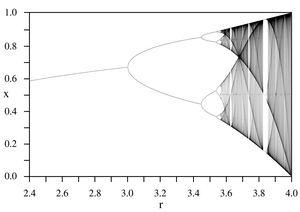Chaotic Dynamics
 The map defined by x → 4 x (1 – x) and y → x + y if x + y < 1 (x + y – 1 otherwise) displays sensitivity to initial conditions. Here two series of x and yvalues diverge markedly over time from a tiny initial difference.
The map defined by x → 4 x (1 – x) and y → x + y if x + y < 1 (x + y – 1 otherwise) displays sensitivity to initial conditions. Here two series of x and yvalues diverge markedly over time from a tiny initial difference.
In common usage, "chaos" means "a state of disorder". However, in chaos theory, the term is defined more precisely. Although there is no universally accepted mathematical definition for a dynamical system to be classified as chaotic, it must have the following properties:
- it must be sensitive to initial conditions;
- it must be topologically mixing; and
- its periodic orbits must be dense.
The requirement for sensitive dependence on initial conditions implies that there is a set of initial conditions of positive measure which do not converge to a cycle of any length.
[edit]Sensitivity to initial conditions
Sensitivity to initial conditions means that each point in such a system is arbitrarily closely approximated by other points with significantly different future trajectories. Thus, an arbitrarily small perturbation of the current trajectory may lead to significantly different future behaviour. an alternative, and in general weaker, definition of chaos uses only the first two properties in the above list. It is interesting that the most practically significant condition, that of sensitivity to initial conditions, is actually redundant in the definition, being implied by two (or for intervals, one) purely topological conditions, which are therefore of greater interest to mathematicians.
Sensitivity to initial conditions is popularly known as the "butterfly effect", so called by Edward Lorenz
nonlinear equation,graphical representation:
x → r x (1 – x). Each vertical slice shows the attractor for a specific value ofr. The diagram displays period-doubling as r increases, eventually producing chaos.
Source: wikipedia.org
Kaotik sistemleri tanımlama methodları:
Sistemin zamanla değişimini görüp,o sistemin kaotik olup olmadığına karar verebilmemiz için o sistemin zaman serilerine ihtiyacımız vardır. (zamana göre sistemin bir değişkeninin hareket dataları)
1 imkb 100 kağıdının 10 yıllık verisi,arıların 3 yıllık nüfus artışı datası, herhangi bir mekanik aletin zamanla titreşimleri.
Bir zaman serisinin kaotikliğini sınayan başlıca metodlar:
Lyapunov Üstelleri:
İlk defa Aleksandr Mikhailovich Lyapunov tarafından tanımlanan bu yöntem, bir zaman serisinin kaotik bileşenler içerip içermediğini anlamamıza yarayan matematiksel bir analiz yöntemidir. Lyapunov üsteli, bir sistemin olası durumlarını gösteren “çeker”ler üzerinde, başlangıçta yakın komşu olan iki rastgele noktanın birbirlerinden ayrılma derecesinin sayısal bir fadesidir. Eğer bu komşu noktalar hızla birbirlerinden ayrılıyorlarsa, hesaplanan en büyük Lyapunov üsteli pozitif bir değerde olacaktır ve bu da incelenen sistemin davranışının kaotik olduğuna dair önemli bir işarettir. Başka bir deyişle Lyapunov üsteli, “başlangıç şartlarına hassas bağlılık” özelliğinin sayısal bir göstergesidir.
En büyük Lyapunov üstelinin pozitif olması kaotik durumun bir gostergesidir. Laypunov üstellerinin sayısı sistemin kurgulandığı faz uzayının boyut sayısına göre değişir. Örneğin, üç boyutlu bir faz uzayında karşılaşılabilecek Lyapunov üstelleri (λ1, λ2, λ3) şöyledir; (-,-,-): sabit nokta, (0,-,-): limit döngü, (0,0,-): simit, (+,0,-): garip çeker (kaos). Lyapunov üsteli hesaplamaları genellikle uzun süreli ve temiz kaydedilmiş zaman serileri üzerinde en iyi sonucu verirken, daha kısa süreli ve kısmen gürültülü sinyaller üzerinde yapılacak hesaplamalar için ilave bazı algoritmalar kullanılması gerekir.
Poincaré Kesiti :
Oluşturulan çekerler (attractor) genellikle çok karmaşık yapılara sahip olabilirler ve görsel olarak incelenmesi çoğu zaman oldukça zordur. Poincaré kesitleri olarak bilinen yöntem bu zorluğu aşmadaki en önemli yardımcılardan birisidir. Adından da anlaşılacağı üzere, bu yöntemle, karmaşık yapılı kaotik çekerlerin istenen herhangi bir noktasından geçen kesitler alınarak, bu kesitlerin görünümlerine ve özelliklerine göre sistem hakkında bazı yargılara varılabilir. Bu yöntem, canlı dokuların yapısını anlamak için onlardan ince kesitler alınarak mikroskop altında incelenmesine dayanan histoloji biliminin işlevine çok benzer.
Faz uzayına çizilen çekerlerden elde edilen kesitlerin görüntüleri sistemin dinamiği hakkında da bir fikir verir. Nasıl ki bir simitten alınan kesit bir daire veya elips olarak karşımıza çıkarsa, burada da kesitlerin görüntüleri, faz uzayındaki çekerin yapısı hakkında bize bir çok fikirler verir. Özetle söylemek gerekirse, Poincaré kesitindeki noktaların dağılımı tek ve küçük bir bölgede sonlu sayıda ise hareket periyodik, kapalı bir eğri ise hareket yarı periyodik, belirli alanlarda yoğunlaşmış kümeler şeklinde ise hareket kaotiktir.
İlk defa Aleksandr Mikhailovich Lyapunov tarafından tanımlanan bu yöntem, bir zaman serisinin kaotik bileşenler içerip içermediğini anlamamıza yarayan matematiksel bir analiz yöntemidir. Lyapunov üsteli, bir sistemin olası durumlarını gösteren “çeker”ler üzerinde, başlangıçta yakın komşu olan iki rastgele noktanın birbirlerinden ayrılma derecesinin sayısal bir fadesidir. Eğer bu komşu noktalar hızla birbirlerinden ayrılıyorlarsa, hesaplanan en büyük Lyapunov üsteli pozitif bir değerde olacaktır ve bu da incelenen sistemin davranışının kaotik olduğuna dair önemli bir işarettir. Başka bir deyişle Lyapunov üsteli, “başlangıç şartlarına hassas bağlılık” özelliğinin sayısal bir göstergesidir.
En büyük Lyapunov üstelinin pozitif olması kaotik durumun bir gostergesidir. Laypunov üstellerinin sayısı sistemin kurgulandığı faz uzayının boyut sayısına göre değişir. Örneğin, üç boyutlu bir faz uzayında karşılaşılabilecek Lyapunov üstelleri (λ1, λ2, λ3) şöyledir; (-,-,-): sabit nokta, (0,-,-): limit döngü, (0,0,-): simit, (+,0,-): garip çeker (kaos). Lyapunov üsteli hesaplamaları genellikle uzun süreli ve temiz kaydedilmiş zaman serileri üzerinde en iyi sonucu verirken, daha kısa süreli ve kısmen gürültülü sinyaller üzerinde yapılacak hesaplamalar için ilave bazı algoritmalar kullanılması gerekir.
Poincaré Kesiti :
Oluşturulan çekerler (attractor) genellikle çok karmaşık yapılara sahip olabilirler ve görsel olarak incelenmesi çoğu zaman oldukça zordur. Poincaré kesitleri olarak bilinen yöntem bu zorluğu aşmadaki en önemli yardımcılardan birisidir. Adından da anlaşılacağı üzere, bu yöntemle, karmaşık yapılı kaotik çekerlerin istenen herhangi bir noktasından geçen kesitler alınarak, bu kesitlerin görünümlerine ve özelliklerine göre sistem hakkında bazı yargılara varılabilir. Bu yöntem, canlı dokuların yapısını anlamak için onlardan ince kesitler alınarak mikroskop altında incelenmesine dayanan histoloji biliminin işlevine çok benzer.
Faz uzayına çizilen çekerlerden elde edilen kesitlerin görüntüleri sistemin dinamiği hakkında da bir fikir verir. Nasıl ki bir simitten alınan kesit bir daire veya elips olarak karşımıza çıkarsa, burada da kesitlerin görüntüleri, faz uzayındaki çekerin yapısı hakkında bize bir çok fikirler verir. Özetle söylemek gerekirse, Poincaré kesitindeki noktaların dağılımı tek ve küçük bir bölgede sonlu sayıda ise hareket periyodik, kapalı bir eğri ise hareket yarı periyodik, belirli alanlarda yoğunlaşmış kümeler şeklinde ise hareket kaotiktir.
Çeker oluşturma :
Zamanla değeri değişen bir değişkenin kaotik analizi için ilk basamaklardan birisi genellikle sistemin davranışının faz uzayındaki görünümünün elde edilmesidir. Bir dizi karmaşık hesap gerektiren bu süreç, bilgisayarlar yardımıyla bugün kolaylıkla gerçekleştirilebilmektedir. MATLAB gibi yazılımların içinde bu işlem için kullanılabilecek hazır makro ve algoritmalar mevcuttur. Çeker oluşturmak için bilinmesi gereken en önemli parametre “gömme boyutu” denen parametredir. Gömme boyutu, sistemin davranışlarını etkileyen bağımsız dinamik kaynakların sayısını tahmin eden bir hesaplamadır ve böylece incelenen sistemin davranışının en iyi biçmde görsel hale getirilebilmesi için kaç boyutlu bir faz uzayına ihtiyaç olduğu bu şekilde hesaplanır. Görsel tutarlılık açısından üç boyuttan daha büyük gömme boyutları pek tercih edilmese de bazı karmaşık kaotik sistemlerde çok daha büyük boyutlu faz uzaylarına ihtiyaç duyulabilmektedir. Gereken bir diğer parametre de “zaman gecikmesi” parametresidir. Bu hesaplama sonucunda, zaman serisinin hangi zaman aralıklarında geciktirilerek grafiğe dökülmesi gerektiği hesaplanır.
Zamanla değeri değişen bir değişkenin kaotik analizi için ilk basamaklardan birisi genellikle sistemin davranışının faz uzayındaki görünümünün elde edilmesidir. Bir dizi karmaşık hesap gerektiren bu süreç, bilgisayarlar yardımıyla bugün kolaylıkla gerçekleştirilebilmektedir. MATLAB gibi yazılımların içinde bu işlem için kullanılabilecek hazır makro ve algoritmalar mevcuttur. Çeker oluşturmak için bilinmesi gereken en önemli parametre “gömme boyutu” denen parametredir. Gömme boyutu, sistemin davranışlarını etkileyen bağımsız dinamik kaynakların sayısını tahmin eden bir hesaplamadır ve böylece incelenen sistemin davranışının en iyi biçmde görsel hale getirilebilmesi için kaç boyutlu bir faz uzayına ihtiyaç olduğu bu şekilde hesaplanır. Görsel tutarlılık açısından üç boyuttan daha büyük gömme boyutları pek tercih edilmese de bazı karmaşık kaotik sistemlerde çok daha büyük boyutlu faz uzaylarına ihtiyaç duyulabilmektedir. Gereken bir diğer parametre de “zaman gecikmesi” parametresidir. Bu hesaplama sonucunda, zaman serisinin hangi zaman aralıklarında geciktirilerek grafiğe dökülmesi gerektiği hesaplanır.
Doğrusalsızlığın Tesbiti :
Bir zaman serisinde izlenen sinyallerin doğrusal olup olmadığını anlamanın da bazı matematiksel yolları vardır. Bir dizi karmaşık matematiksel teknikle, bilgisayarların hızlı işlem gücünü de kullanarak bugün bu işlemler hızlı bir biçimde yapılabilmektedir. Bu amaçla en çok kullanılan yöntem surrogate data analysis denen yöntemdir. Bu analiz tipinde, eldeki sinyalin bir bezerini oluşturmak için doğrusal bir algoritma kullanılır ve üretilen yapay sinyalle gerçek sinyal arasındaki ilişkiler incelenir. Eğer ilişki yoksa, sonuçta sinyalin doğrusal olmadığı gösterilmiş olur. Bu yöntemin yanında daha başka bir çok hesaplama tekniği de önerilmiştir fakat hepsinin de sadece belli durumlarda geçerli olmasına neden olan bazı zayıflıkları vardır .
Fraktal boyut analizi
Daha önce bahsedildiği gibi “fraktal” terimi, değişik ölçeklerde artarak karşımıza çıkan karmaşıklığın bir ifadesidir. Bir geometri alanı olmasının yanı sıra, özellikle zaman serilerinin karmaşıklık ve kaotiklik özelliklerini belirlemek için kullanılır. Fraktal sinyal analizi, fraktal doku analizi gibi farklı tekniklerin kullanıldığı bu tip analizlerde temel amaç zaman serisinin karmaşıklığının saptanmasıdır. Bir zaman serisinin fraktal boyutlarının artışı sürecin karmaşıklığının bir ölçüsü olarak kullanılmaktadır.
Bir zaman serisinde izlenen sinyallerin doğrusal olup olmadığını anlamanın da bazı matematiksel yolları vardır. Bir dizi karmaşık matematiksel teknikle, bilgisayarların hızlı işlem gücünü de kullanarak bugün bu işlemler hızlı bir biçimde yapılabilmektedir. Bu amaçla en çok kullanılan yöntem surrogate data analysis denen yöntemdir. Bu analiz tipinde, eldeki sinyalin bir bezerini oluşturmak için doğrusal bir algoritma kullanılır ve üretilen yapay sinyalle gerçek sinyal arasındaki ilişkiler incelenir. Eğer ilişki yoksa, sonuçta sinyalin doğrusal olmadığı gösterilmiş olur. Bu yöntemin yanında daha başka bir çok hesaplama tekniği de önerilmiştir fakat hepsinin de sadece belli durumlarda geçerli olmasına neden olan bazı zayıflıkları vardır .
Fraktal boyut analizi
Daha önce bahsedildiği gibi “fraktal” terimi, değişik ölçeklerde artarak karşımıza çıkan karmaşıklığın bir ifadesidir. Bir geometri alanı olmasının yanı sıra, özellikle zaman serilerinin karmaşıklık ve kaotiklik özelliklerini belirlemek için kullanılır. Fraktal sinyal analizi, fraktal doku analizi gibi farklı tekniklerin kullanıldığı bu tip analizlerde temel amaç zaman serisinin karmaşıklığının saptanmasıdır. Bir zaman serisinin fraktal boyutlarının artışı sürecin karmaşıklığının bir ölçüsü olarak kullanılmaktadır.







